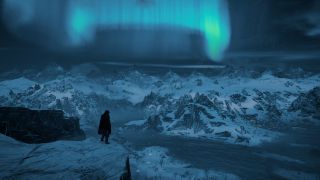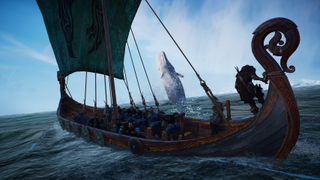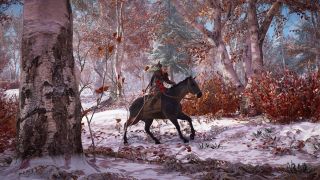You shouldn't rush straight into Assassin's Creed Valhalla's story
Stop and smell the cloudberries.

After a dramatic introduction, Assassin's Creed Valhalla turns you loose on a beautiful, rugged slice of 9th Century Norway. The game tells you to sail home to your village, but resist the urge. Doing so sets Valhalla's story in motion, and before you know it you'll be taking a longboat to England. Instead, untrack that quest, disable the game's navigation aids, and explore at your own pace.
I instantly fell in love with Valhalla's frozen Norwegian landscape, and decided I wanted to spend as much time there as possible before crossing the North Sea. Like in Origins and Odyssey, you can summon a bird companion—here, a raven named Synin—to scout the map for you. Doing so reveals yellow, blue, and white icons, which represent wealth, mysteries, and artifacts.

Wealth could mean a chest full of rare crafting materials, a silver horde, a new weapon, or Books of Knowledge, which grant you special combat abilities. Artifacts could be new tattoo designs or objects that provide some narrative colour to the world. And mysteries, the most interesting of the three, are side quests. You can also reveal these icons by climbing tall buildings or terrifyingly high mountain peaks, of which this part of Norway has many.
Before I even considered kicking Valhalla's story into gear, I spent around 12 hours sailing, riding, and hiking around the fjords, investigating these markers whenever I happened to be near one. If you just move blindly from icon to icon, you'll fall into that familiar Ubisoft open world trap of just ticking off a giant checklist. But if you explore the world with no particular goal in mind, stumbling on things rather than seeking them out, it feels more organic.
Valhalla has three separate difficulty modes for exploration, combat, and stealth
Valhalla has three separate difficulty modes for exploration, combat, and stealth. Set exploration to pathfinder, the 'hardest' setting of the three, and certain navigation aids will be removed or minimised—including, crucially, how far away things are from you. This makes you feel like you're actually exploring rather than just following a trail of breadcrumbs left by the developer. And I think it's the best way to play the game if, above all, exploring the world is what you're most interested in.
There are unmarked things to find too, including a treasure hunt, some neat environmental storytelling, and wildlife to snap with the game's excellent photo mode. I spent an hour just observing and taking photos of puffins, whales, arctic foxes, and polar bears, like a viking David Attenborough. Norway is small as far as Ubisoft worlds go (and much tinier than England, where the bulk of the game takes place), but it's packed with fun, interesting stuff.

The side quests are particularly good. As you explore you meet all manner of eccentrics and oddballs out in the snow. These include a guy who's convinced the tiny, frozen island he's trapped on is actually England, a man desperate to prove himself in battle who asks you to lure a polar bear into his camp (you can guess how this ends), and a married couple who want you to rekindle their romance by, well, you'll see. It's weird. These quests are quirky and light-hearted, which sets them apart from the more serious main story.
The biggest gaming news, reviews and hardware deals
Keep up to date with the most important stories and the best deals, as picked by the PC Gamer team.
As well as making exploration more satisfying, there are material benefits to holding back on the story too. By the time you get to England you'll have levelled up a lot, with a sizable stash of silver in your purse, upgraded gear, a wider spread of abilities, and a tidy arsenal of weapons to choose from. You can always return to Norway later to mop up anything you missed, and presumably visit an area of the map that's blocked off early in the game. But doing as much as you can there before going to England gives you a nice head start.

It also serves the story. When I eventually started the story missions that lead to Eivor deciding to head to greener shores, I'd already spent many hours in her sealskin shoes, exploring the land she calls home, becoming familiar with its beauty and dangers—and as a result, she felt like a more rounded character. And when I eventually left the wintry shores of Norway behind and arrived a week later in leafy, sunny England, the transition hit way harder.
It's such a sharp contrast of atmosphere, climate, flora, fauna, and everything else, and gives you an evocative sense of how real Scandinavian explorers would have felt arriving in a place like this for the first time. So if you're playing Assassin's Creed Valhalla and you see that first big quest marker leading you to Eivor's village, just ignore it for a while. Jump in your longboat, head out to sea, ask your crew to sing a rousing shanty, and see what you can find.
- AC Valhalla guide: 6 top tips
- AC Valhalla romance: Find love in Dark Ages Britain
- AC Valhalla armor: The best you can find
If it’s set in space, Andy will probably write about it. He loves sci-fi, adventure games, taking screenshots, Twin Peaks, weird sims, Alien: Isolation, and anything with a good story.
Most Popular

